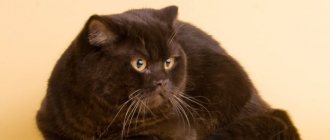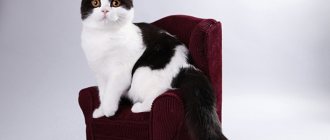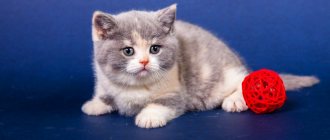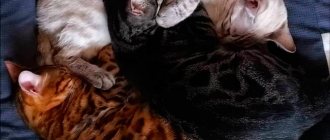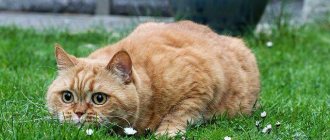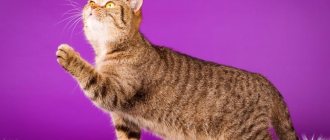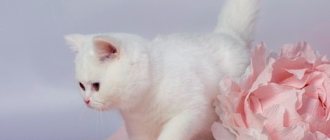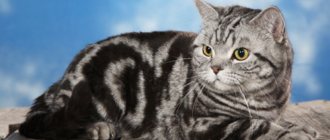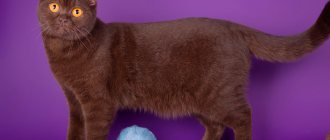Abbreviated breed names Colors Color variations Eye colors
In the modern world there are more than 40 cat breeds and more than 200 different colors. a classification of cats generally accepted in the world .
In each breed, any coat color and eye color corresponds to a certain digital coding.
Let's look at the example of the most common color of a British cat: “shaded silver” BRI ns 11 64 . In general, the breed and color code consists of 4 blocks:
- BRI is the abbreviated name for the breed. In this case, British (all breeds).
- ns – color. May contain one or two letters. If there is only one letter, then the color is monochromatic and in this case the third block in the encoding (color variation) is absent. In the example under consideration, this is a black and silver color (all colors).
- 11 - color variation. In this case, shaded, when the guard hair is colored 1/3 of the length (all color variations).
- 64 - eye color, in this case green. Often, eye color is not indicated in the metric or pedigree, if it is standard for a given color. A rarer eye color (blue or Siamese) is always indicated to emphasize its exclusivity (all eye colors).
The silver shaded color (ns 11) is characterized by a white undercoat and guard hairs with black tipping, especially pronounced on the back and tail. This color is much darker than the silver chinchilla (ns 12), because black and silver coloring covers 1/3 of the length of the entire hair, and in the silver chinchilla (ns 12) the predominance of white undercoat is more pronounced, silver coloring is only 1/8 of the length of the hair. In this case, the chin, belly and ears should be exclusively white. Even on the paws and between the toes, dark hairs are considered a defect in this color. Thus, the full name of a British silver chinchilla cat with emerald eyes will be BRI ns 12 64.
Patterned colors are also very popular among the British, for example BRI ns 22 (silver marble, classic tabby). The same color of the kitten from the well-known Whiskas advertisement.
The colors of British cats are classified in the same way as other breeds. For example, a Scottish fold cat of a silver shaded color with green eyes is SFS ns 11 64. Where SFS is a Scottish breed. And the straight-eared Scotsman of the same color is SFS 71 ns 11 64. Here you should pay attention to the number 71 after the abbreviated name of the breed. This is a special case specifically for the Scots, meaning that it is straight (straight-eared). This color will also be recorded in other breeds: EXO ns 11 64, PER ns 11 64, etc.
Solid colors of the British
Some of the solid (with an emphasis on the "o"), or solid colors - such as blue - are the ancestors of the British colors, and some - new colors - were obtained through the labor-intensive work of breeders. The rarest solid colors are cinnamon and fawn.
White
Snow-white without yellowness. Kittens may have black or gray spots on their heads from birth, which disappear with age. The eyes can be blue, and heterochromia (difference of eyes) also occurs. Breeding experiments with this color have ended because too many kittens are being born with health problems. For example, deafness in white cats with blue eyes is common.
Black
The coal-black, raven-wing colors of British cats give the animal a witchy, magical appearance. But, unfortunately, it is difficult to guess that a black kitten will become a blue-black cat. Very often, kittens change color around six months, changing the color of their fur to chocolate.
Chocolate
The richer and darker the better. Kittens that have faded from black are usually not the most successful (brown) color. Noble dark chocolate is desirable.
Blue
It can be a little lighter and a little darker. The bluer the shade, the more valuable it is. The undercoat is sometimes lighter than the main hairs, but the difference should be minimal.
Lilac
A complex color that is a cross between blue and pink. The result of selection work. Kittens are born dull pink; With age, the animal acquires a light coffee-with-milk shade, with a pinkish tint.
Cream
Beige or peach shades. Kittens can be born with a variegated coat, but then the variegation goes away.
Faun
"Deer" color, even lighter than cinnamon cinnamon. In infancy, such a kitten can be confused with a cream kitten, but the older the pet, the more clearly the gray tone appears (in cream cats, red predominates).
Cinnamon (cinnamon)
A rare color, cinnamon color, similar to light chocolate with the addition of an orange tint.
Interesting facts, beliefs and signs about black Britons and more
The black breed of British cats traditionally arouses interest and curiosity. The signs accompanying these animals are diverse not only in nature, but also in geographical location.
- The black cat is the only animal that has its own holiday. It was founded by Italian cat lovers and falls on November 17th.
- “It will be unlucky if a black cat crosses the road” - this is not the common belief in all countries. Black Britons are very lucky. In England, they are endowed with positive properties, and the woman who has such a cat will always be the center of attention.
- The Irish believe that the charcoal anthracite cat brings wealth and prosperity.
- Even superstitious British sailors willingly took black cats on risky voyages. They believed that animals of this color bring good luck.
- In Russia there has always been an ambivalent attitude towards black cats. Having met them, in the old days people were baptized and cursed the evil one. But at the same time, they believed that black cats scared away thieves and guarded the house.
- Of all the breeds that have been officially registered in the world, only 22 have representatives of pure black color. The British Shorthair is one of them.
There is also an interesting observation: the population of black Britons is larger in cities than in rural areas. According to one version, this is due to the fact that black cats adapt better to urban conditions than their tabby or tortoiseshell counterparts.
Such “fatal” Britons, as a rule, are created by wealthy people, extraordinary personalities, prone to exaltation. They rarely live alone; the doors of their home are usually open to numerous guests.
It has been noticed that even the British, who are reserved and selfish by nature, show sociability in such conditions and often become the center of attention.
Color point colors
Color introduced into the breed by breeders. Sometimes it is also called “Siamese” or “Himalayan”. It has a rich palette of shades. According to the standard, a light body without spots and darkened legs, head, and tail. Wool with white undercoat. The eyes are blue, from watery-transparent to sapphire, bright blue, which is especially appreciated.
British pointing kittens are born almost white, with dark fur growing into adolescence, or even later. Over the years, both light and darker coats darken.
Black point (classic, seal point)
The most common color. On the body, the fur coat can range from white to almost chocolate color; the point markings are dark brown, turning into black. The nose and paw pads are black or black-brown.
Chocolate point
Rare beautiful color, one of the brightest. The cat's body is creamy in color, and the point markings are a rich chocolate color, which should be even and bright. The nose and paw pads are brown, maybe with a pinkish tint.
Blue point
Delicate, soft color. Cold tone. Gray-blue body and blue point markings. Looks very harmonious with ice blue eyes. The nose and paw pads are gray.
Lilac point
In this color there should be no sharp boundaries between the main color (white or almost white with a pinkish tint) and the gray-pink point markings. However, the difference in tones should be clearly visible. The nose and paw pads are gray-pink.
Red point
Quite a rare color. White or with a reddish tint coat, bright red point spots. The brighter the red, the better. Ideally, brick red color. The nose and paw pads are red to coral.
Cream point
Delicate creamy body color and smooth, easy transition to creamy point markings. The brightest spots are pink or coral nose and paw pads, as well as blue eyes.
Color point tortoises
A combination of two colors: color point and tortoiseshell. Delicate interesting color. Light body and spotted, mosaic markings. Point marks may contain a combination of any colors from the palette; soft, pastel colors are valued. The nose and paw pads match the base color.
Smoky color point
An interesting miracle of nature, or rather, the result of the work of breeders. Cats are carriers of two colors. The body can be any of the "smoke" colors: black smoke, blue smoke, lilac smoke, chocolate smoke, red smoke, cinnamon and fawn. Point markings are the same color, but darker. The undercoat is white, the nose and paw pads match the color.
Veiled color point
There are two types: on silver and on gold. On a silver-white or peach undercoat. Tipping on the back colors 1/8 of the hair in the tone of one color or another, point spots of the same color: black, blue, lilac, chocolate, red, cream, cinnamon and fawn. The nose and paw pads match the color.
Shaded color point
There are two types: on silver and on gold. On a silver-white or peach undercoat. Tipping on the back colors 1/3 of the hair to match the color of a particular color; point marks without sharp boundaries can be small. Black, blue, lilac, chocolate, red, cream, cinnamon and fawn. The nose and paw pads match the color.
Color point bicolor
Consists of two colors: white and any of the palette with point marks. As a rule, the chest, part of the body, the front legs are white, and there are also white spots on the cheeks. The symmetry of white spots and their harmonious arrangement are appreciated. Markings include black, blue, lilac, chocolate, red, cream, cinnamon and fawn. The nose and paw pads match the base color.
Fawn point
Light sandy body and light brown and beige markings. Exactly the deer shade, without the redness. Beige nose, beige paw pads.
Cinnamon Point
A very rare color, a breeders dream. Ivory coat and red-brown pointing markings. Red and pink-brown nose and paw pads.
ticked tabby
A color in which there is no pattern on the body, the entire body is evenly covered with ticked (i.e. striped) hairs. It is formed by the Ta gene, the most dominant of all patterned colors. In the homozygous manifestation, the ticked color lacks not only stripes on the body, but also on the tail, paws and chest; in the heterozygous form, the body is ticked without a pattern, and there are stripes on the points. Although the most dominant form of the tabby gene, it is very rare in the British breed and was introduced into it through the Abyssinian breed. There are quite old purebred breed lines where the Abyssinians have long since become a thing of the past, leaving behind such an unusual color as a gift.
Tortoiseshell colors
The amazing thing about calico cats is that each one is unique. There are no identically colored turtles. Color types: finely spotted or patchwork, calico (spots on white). A very interesting joke of nature: only cats are tortoiseshells. Well, practically. Calico cats are much more rare than white crows. Cats can have such colors only due to a genetic error with chromosomes. Most breeders and felinologists, having worked with animals all their lives, have never encountered tricolor cats. But yes, one day such a kitten may be born. Unfortunately, there will be no offspring from him, although history knows exceptions. Turtles also include chimera cats, which amaze everyone with their appearance, whose faces are neatly painted in different colors. Chimerism is also a genetic anomaly.
There are six main subgroups of this color: classic tortoises, smoky tortoises, torbie (tortoiseshell tabby), tortie (tortoiseshell point), calico (patchwork tortoise) and mixed color (tortoiseshell tabby and white).
Bicolor tortoiseshell
This color is also called calico, or patchwork tortoiseshell. The brightest, most elegant color. On a white background there are colored spots, the boundaries of which are not blurred or mixed. The spots can be any color from the palette. Pigmented spots should cover more than a third of the body surface. If there are few colored spots on a white background, such animals are called harlequin or van.
Black and red tortoiseshell
Ideally, a cat should have approximately 50% red and 50% black spots. The brighter the spots, the better. Brownish and beige spots are the same red color, only lightened. According to the standard, a red spot on the forehead is very desirable.
Chocolate red tortoiseshell
Interesting, rarely seen color. Ideally, a cat should have approximately 50% red and 50% black spots. The brighter the spots, the better. There should be a light spot on the forehead.
Blue-cream tortoiseshell
Soft, delicate, very noble color. Pastel colors (blue and cream) blend smoothly into each other. White spots and even hairs are not allowed.
Lilac-cream tortoiseshell
Purple and cream spots are neatly distributed throughout the animal's body. White inclusions are not allowed. There should be a cream spot on the cat's face.
Cinnamon-red tortoiseshell
Rare tortoiseshell color variant. The color of the fur coat is warm and rich. The spots are evenly distributed; there should be a red spot on the animal's face.
Fawn-cream tortoiseshell
This color is rare. The spots are not bright, but nevertheless they should have a different color. White wool and residual tabby color are not allowed. But there should be a cream mark on the forehead.
Patterned
Any color can be patterned.
The shape of the pattern is determined by a series of T (tabby) genes. And such genes are present in the genotype of absolutely every cat. But, as you know, not every cat is striped or spotted. It's all about another gene - A (agouti). This gene either “turns on” or “turns off” as the hair grows, coloring the hairs in transverse rings with alternating dark and light tones. Decoding the colors of cats begins with a search for two genes in the genotype - T and A. If there is at least one A, the cat will be patterned. If there are two aa in the genotype (homozygous recessive set), the fur coat will be colored evenly, since without ticking (coloring the fur in stripes) a pattern is impossible. So, what does the color of a tabby cat mean? The answer is obvious: the cat is a carrier of the dominant agouti gene (A). Now let's look at the tabby gene (T):
Ta (Abyssinian) is dominant to T (stripes), and T is dominant to Tb (marble). But there are still spots! But with them it’s more complicated: either there is a specific gene that allows spotting to appear, or the spots are the result of the work of a group of modifier genes that “break” the stripes (the latter is more likely).
Tabby colors
The main signs of a tabby (or wild color) are the letter M located on the animal’s forehead (according to legend, this is the sign of a scarab), dark stripes near the eyes and on the cheeks, as well as rings (necklace) on the neck and chest.
Marbled Tabby
Dark circles, swirls and patterns on a light background. The pattern should be clear, not tangled or intersecting.
Spotted Tabby
Stripes on the cheeks, a dotted stripe along the ridge, and spots on the sides, preferably clearly defined and bright, are required. The cat is a micro-leopard.
Striped tabby
Brindle (sprat, mackerel, striped) is the most common tabby color. Mackerel (mackerel) fish, as well as sprat fish, have tiger stripes on their scales, just like cats have on their fur, hence the name.
Distinctive features are a dark stripe along the ridge, extending onto the tail, and striped sides. It is important that the stripes are not interrupted and do not turn into spots. The cat is a micro-tiger.
Patterned with white (torbico)
Quite a rare color, consists of three: tabby, tortoiseshell, white. On a white background there are colored spots with one of the tabby patterns.
Pictured tortoiseshell (torby)
The animal has a tabby pattern under any of the coat colors (black-red, chocolate-red, blue-cream, lilac-cream, as well as cinnamon-red and fawn-cream).
Silver tabbies
The cat's fur has a black pattern (stripes, spots, marble), and a white and silver undercoat.
Golden tabbies
The cat's fur has a red pattern (stripes, spots, marble), and an apricot undercoat.
List of cat genes responsible for mutations of ears, tails and paws
| № | ( or ) | Comments | |
| 1 | FdFd | lop-eared | in addition to ear deformation in cats, the allele causes osteochondrodysplasia |
| 2 | Fdfd | lop-eared | healthy animal |
| 3 | Cu- | ears rolled back | |
| 4 | MM | embryo death | that's all |
| 5 | mm | no tail or bob tail | -//- |
| 6 | btbt | bob ponytail | only |
| 7 | kk | wedge-shaped vertebrae | believed to be responsible for deformed tails in cats, and |
| 8 | MkMk | the embryo does not develop | only munchkin and other dwarves |
| 9 | Mkmk | short legs | -//- |
Note: the genetics of the tails of all bobtails except the Japanese are unknown, presumably bob tails are inherited polygenically; The American Ringtail's tail is probably determined by a recessive gene (designation unknown).
List of cat genes responsible for rare mutations
| № | ( or ) | Comments | |
| 1 | sfsf | baldness around the eyes and mouth | probably the breed-forming gene of Lykoi |
| 2 | sasa | cotton wool (fine, brittle and thick) | |
| 3 | Cat- | ||
| 4 | brbr | brachyuris (short-tailed) | only for |
| 5 | Pd | (extra toes) | |
| 6 | Sh- | (fusion of toes) | |
| 7 | Rh- | (kangarooism) | extra joint (toe), short foot |
| 8 | dpdp | four ears | also leads to underbite, smaller eyes and a tendency to lethargy |
| 9 | tete\mcmc | ||
| fckfck | |||
| 10 | chch | death syndrome | |
| 11 | popo | only the first type | |
| 12 | rdgrdg | ||
| 13 | Rdy- | only in Abyssinian cats | |
| 14 | rtrt | found only in | |
| 15 | ndnd | ||
| 16 | slsl | ||
| 17 | Ga-1-\ga-2ga-2 | ||
| 18 | mpsmps | ||
| 19 | mama | ||
| 20 | splspl | ||
| 21 | hyhy | ||
| 22 | trtr | ||
| 23 | ewew | found among Burmese | |
| 24 | sptspt | found in | |
| 25 | hmahma\hmbhmb | ||
| 26 | haghag | ||
| 27 | hcehce | ||
| 28 | Ph- | ||
| 29 | hoho | ||
| 30 | tfmtfm | ||
| 31 | hcmhcm |
Silver chinchilla
It is still a rare, difficult to breed, but very beautiful, “royal” variety of the British cat. The color is so named because of its resemblance to the fur of real chinchillas.
The beauty is the owner of a snow-white fur coat with a “spraying” of the main color tone, black or blue. No yellow shades of wool are allowed. The nose and paw pads should match the base color. The eyes are necessarily green, except for the pointed subspecies. The colors differ in the degree of coloring of the hairs.
Silver shaded
Shaded is when only the upper third of the hairs are colored in the main color. In all other respects, the animal looks like it has a solid color, only slightly “dusted.” This effect is achieved due to the fact that each hair has a colored tip. The undercoat is white.
Silver veiled
Veiling is when the top 1/8 of the hairs are colored. In all other respects, the animal looks the same as with a solid color, only in a barely visible transparent “veil”. This effect is achieved due to the fact that each hair has a colored tip. The undercoat is white.
Golden chinchilla
An even rarer, difficult to breed, but very beautiful, “sunny” variety of the British cat. Its color is so named because of its similarity to the fur of real chinchillas.
This cat wears a bright apricot-colored coat with black or blue “spraying.” The brighter the gold, the more valuable it is. Gray shades are not allowed. The nose and paw pads should match the base color. The eyes are necessarily green, except for the pointed subspecies. The colors differ in the degree of coloring of the hairs.
Golden shaded
Shaded is when only the upper third of the hairs are colored in the main color. In all other respects, the animal looks like it has a solid color, only slightly “dusted.” This effect is achieved due to the fact that each hair has a colored tip. The undercoat is peach or apricot.
Golden veiled
Veiling is when the top 1/8 of the hairs are colored. In all other respects, the animal looks the same as with a solid color, only in a barely visible transparent “veil”. This effect is achieved due to the fact that each hair has a colored tip. The undercoat is peach or apricot.
Smoky colors
“Smoky” can be any of the colors, the main thing is that the undercoat should be lighter than the main color, preferably white. This is one of the varieties of hair color distribution. About half of the hair is colored, and closer to the root half is white. There are also “cameo” colors, in which the color of the undercoat almost merges with the color of the main hairs.
Classic smoky
“Smoke” is superimposed on the same solid coat colors: black-red, chocolate-red, blue-cream, lilac-cream, as well as cinnamon-red and fawn-cream. The undercoat is silvery-white.
Smoky bicolor
The cat has a symmetrically and harmoniously distributed white color and “smoky” spots of any color. The undercoat is white, the nose and paw pads match the base color.
Marble (classic, blotched/marble tabby)
It is the most recessive form of the tabby (tb) gene and the most striking of all patterned colors. On the shoulder blades there is a characteristic pattern in the form of butterfly wings, three wide stripes stretch along the back, concentric circles with a center on the sides, the tail has 2-3 wide stripes, and not many thin ones like a tiger. Ideally, the pattern should be thick and clear, contrasting with the main background. It has a modification - marble, which differs from the classic one in that it has thicker edges and a pale middle (bordered).
Colors with white
A cat can have any of the following colors: black, blue, lilac, chocolate, red, cream, cinnamon and fawn, as well as a combination of these plus white spots. One fourth (no less!) part of the body should be white - this is the chest, front legs, cheeks, and belly. The nose and paw pads should match the base color.
Classic color with white
Strictly speaking, this is a two-colored cat. Elegant white spots (yellowishness is not allowed) and a fur coat of any of the classic colors. The nose and paw pads match the base color.
Smoky color with white
The cat has a symmetrically and harmoniously distributed white color (chest, paws, cheeks) and “smoky” spots of any color.
Color point with white
The elegant coat of such a cat is painted in two colors: white and any of the palettes with point marks. The chest and front legs are white, and there are also white spots on the cheeks. The symmetry of white spots and their harmonious arrangement are appreciated. Markings of black, blue, lilac, chocolate, red, cream, cinnamon and fawn. The nose and paw pads match the base color.
Colors with white tabby
The same patchwork turtles, only some spots may have a tabby pattern. Rarely seen, it is considered a combination of three colors. There may also be spots of the same (any) color, on which a tabby pattern appears (stripes, spots, marble).
Abbreviated breed names
| ABY | Abyssinian |
| BAL | Balinese |
| BOM | Bombay |
| BRI | British |
| BUL | burmilla |
| BUR | Burmese |
| CHA | Chartreux |
| CIM | Kymrik |
| CRX | Cornish Rex |
| DRX | Devon Rex |
| DSX | Don Sphynx |
| EUR | European KSH (shorthair) |
| EXO | exotic KS |
| GRX | german rex |
| JAV | Javanesian |
| J.B.T. | Japanese Bobtail |
| KBL | Kurilian Bobtail DSh (longhair) |
| KBS | Kurilian Bobtail KSh |
| KOR | korat |
| MAN | Manx |
| MAU | Egyptian Mau |
| MCO | Maine Coon |
| MUN | munchkin |
| NFO | Norwegian Forest |
| NEV | Neva Masquerade |
| ORI | oriental |
| PTB | Peterbald |
| PER | Persian |
| PET | domestic cat |
| RAG | ragdoll |
| RUS | Russian blue |
| SBI | sacred burma |
| SCS | Scottish KS |
| SCL | Scottish DS |
| SFL | Scottish fold DS |
| SFS | Scottish fold KSh |
| SIA | Siamese |
| SIB | Siberian |
| SIN | Singapore |
| SNO | snow shoo |
| SOM | Somalia |
| SPH | Canadian Sphynx |
| TUA | angora |
| TUV | turkish van |
How to determine the color of a British cat?
If you really need a kitten of a certain color, you should contact a cattery with a good reputation. It’s not a fact that you will immediately find what you want, especially if the color is rare. Ask for photos, videos; Perhaps they will show you the baby on Skype. Then it’s time to go and choose.
To begin with, visually, but the kitten must already be mature (3-4 months). In babies, the color may change color.
Look at the kitten's parents, talk with the owners, study the breed codes and the summary color table. The exact details of cat fathers and mothers must be indicated in their documents. Using the table, you can determine which kittens a given pair of producers may have.
Well, or you can contact a specialist, an expert felinologist. In the case of rare and complex colors, it is better not to take risks. Interestingly, all cats are initially wild-colored (tabby). That is, spotted. But due to a combination of genes, this color is hidden. Nature's jokes can be observed in small kittens, which, being born with spotted fur, change to one color within a couple of months.
